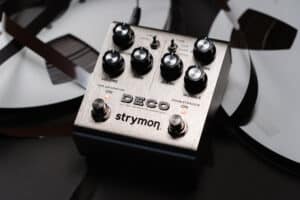
BigSky MX Preset Pack 1
Explore Our First BigSky MX Preset Pack! As part of the latest Nixie 2 update, we’ve put together a free BigSky MX preset pack featuring sounds
Free US Shipping On Orders Over $49
Easy 30-Day Returns
Financing Available Through ![]()
Here at Strymon, we work hard to deliver inspiring tones while keeping every pedal easy to use and pedalboard friendly. We also pack our pedals with many customization options that can sometimes fly under the radar. For example, did you know that Iridium offers three different ambient room sizes? Or that there is a carefully tuned noise gate hiding within our Sunset and Riverside drives? Or that there is a built-in spring reverb on El Capistan?
Why cram in so many extra features under the hood?
We think you deserve easy access to the widest palette of tones possible. We place the settings you’re most likely to grab live right at your fingertips, and then include even more tone sculpting options as secondary functions. From time to time, we hear from players who need a bit of help unlocking the full potential of these secondary functions, and that’s what this blog series is about!
In this series, we’re going one by one through our pedals and describing in detail a specific pedal’s secondary functions, how to access them, and some of the cool sounds you can achieve using these functions.
Today in the second installment of the series, let’s focus on El Capistan dTape Echo.
Some effects pairings just make sense, and one of those is delay and reverb. What better reverb to pair with vintage tape echoes than a lush spring reverb?
This secondary function lets you adjust the mix of El Capistan’s spring reverb in relation to its tape echo. Setting it fully counterclockwise gives you no reverb, and fully clockwise gives you the maximum amount of possible reverb.
To adjust, press and hold the BYPASS and TAP footswitches while the pedal is already powered up, and then turn the TIME knob to the desired position. Release both footswitches to save. By default, the spring reverb secondary level is set to zero.
This handy EQ helps to control the low frequency shaping of your echo repeats.
You can set this to its far left minimum position for extended low frequency bandwidth, or set to its maximum setting at the far right for high-passed, magnetic drum style delays, similar to its big brother, Volante.
To adjust, press and hold the BYPASS and TAP footswitches while the pedal is already powered up, and then turn the TAPE AGE knob to the desired position. Release both footswitches to save. This secondary function is set to noon (50%) by default.
From dark, dirty echoes to sparkling delays, El Capistan does it all with the help of its Tape Bias secondary function.
Use this to adjust the Tape Bias and get crystal clean echoes at lower bias settings (to the left), or get quieter, darker repeats as you turn this control to the right for higher bias levels. For an optimally biased tape machine, set this to 9:00. Set it to minimum for an under biased tape machine with extra high frequency response.
To adjust, press and hold the BYPASS and TAP footswitches while the pedal is already powered up, and then turn the REPEATS knob to the desired position. Release both footswitches to save. By default, this secondary function is set to noon (50%).
This secondary setting highlights one of the reasons why El Capistan is a go-to delay pedal for those seeking vintage mojo with the convenience of modern engineering.
Use this to control the amount and severity of tape irregularities, including friction, creases, splices, and contaminants. Use the minimum setting (fully counterclockwise) for fresh, clean tape delays, and use its maximum setting at the opposite end to get the sound of tape that has been mangled and chewed for years. Note that the Tape Crinkle characteristics track accordingly with the tape speed.
To adjust, press and hold the BYPASS and TAP footswitches while the pedal is already powered up, and then turn the WOW & FLUTTER knob to the desired position. Release both footswitches to save. At its default, this secondary setting is set to noon (50%).
Sometimes you just need that little push. El Capistan has a built in 3db boost/cut that kicks in when the pedal is engaged.
Use this to boost your delayed signal and highlight rhythmic sections of your playing or bring attention to your solos. Cut a few dB in order to tame wild, oscillating echoes.
To adjust, press and hold the BYPASS and TAP footswitches while the pedal is already powered up, and then turn the MIX knob to the desired position. Release both footswitches to save. From the factory, Boost/Cut is set to 12:00 (noon) for no boost or cut of the signal.
Not technically a secondary function, but we felt it was worth mentioning due to it being an essential feature of El Capistan. When the pedal is set to buffered bypass, it will let your wet signal’s decay naturally fade out, even after you have bypassed the pedal.
This is great for when you want to naturally add a touch of delay for only specific portions of a song.
To set El Capistan to buffered bypass and enable trails, start with your pedal disconnected from power. Then, press and hold the BYPASS footswitch while connecting power to your pedal. Release the BYPASS footswitch to save this setting.
We hope that with these secondary functions, you can get the most flexibility and tonal variety from your El Capistan while keeping things simple up front!
Want to learn more about El Capistan? Check out this article that breaks down some of the more technical aspects of the pedal:
If you have questions about these or any other Strymon products, don’t hesitate to reach out to us at [email protected].
Have an idea for a blog or a question about Strymon, our products, or effects in general? Let us know!
Subscribe to our newsletter to be the first to hear about new Strymon products, artist features, and behind the scenes content!

Explore Our First BigSky MX Preset Pack! As part of the latest Nixie 2 update, we’ve put together a free BigSky MX preset pack featuring sounds

If you happen to be one of those Strymon owners who know that their favorite units might have some extra capabilities but can’t remember exactly

From our favorite artists’ new releases to amazing concerts, and existing artists we’re just finding out about, 2024 was a year filled with great music.